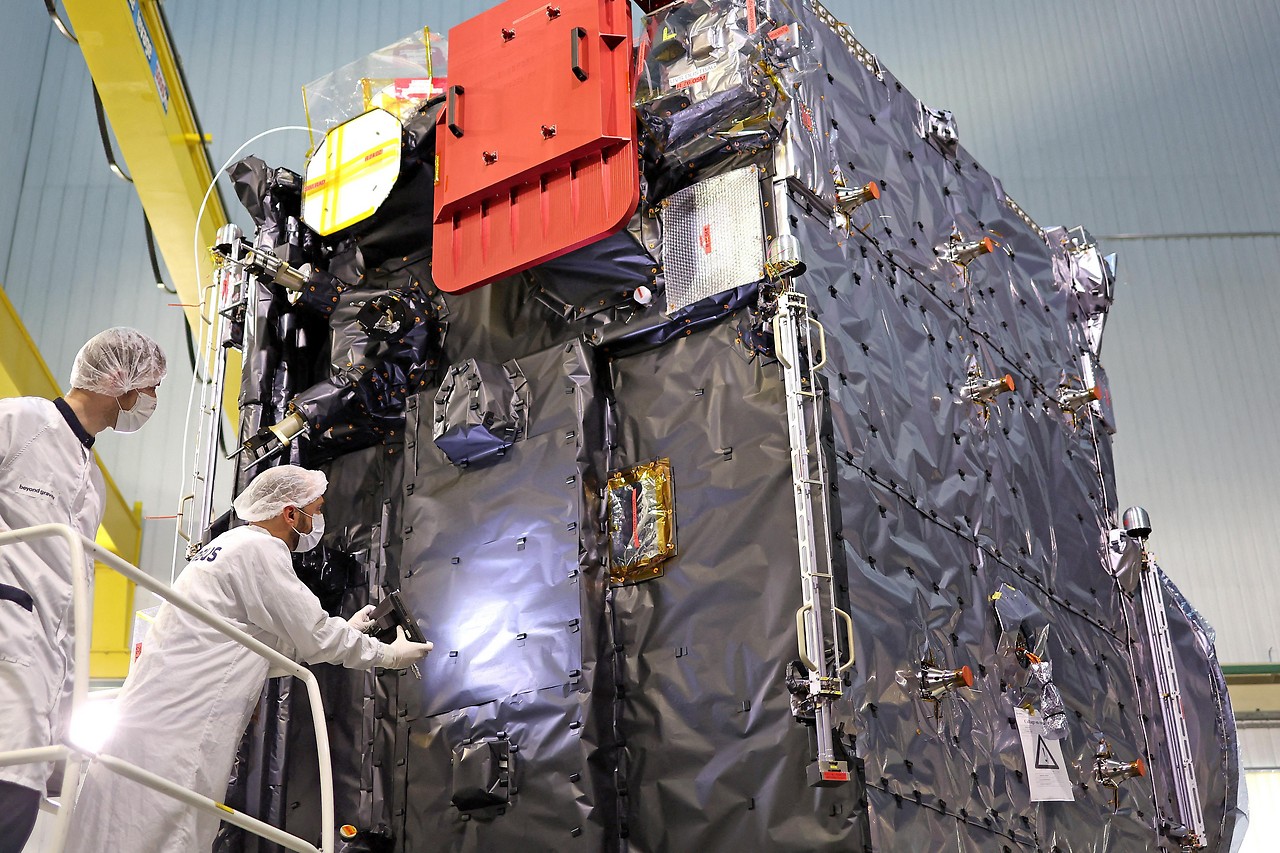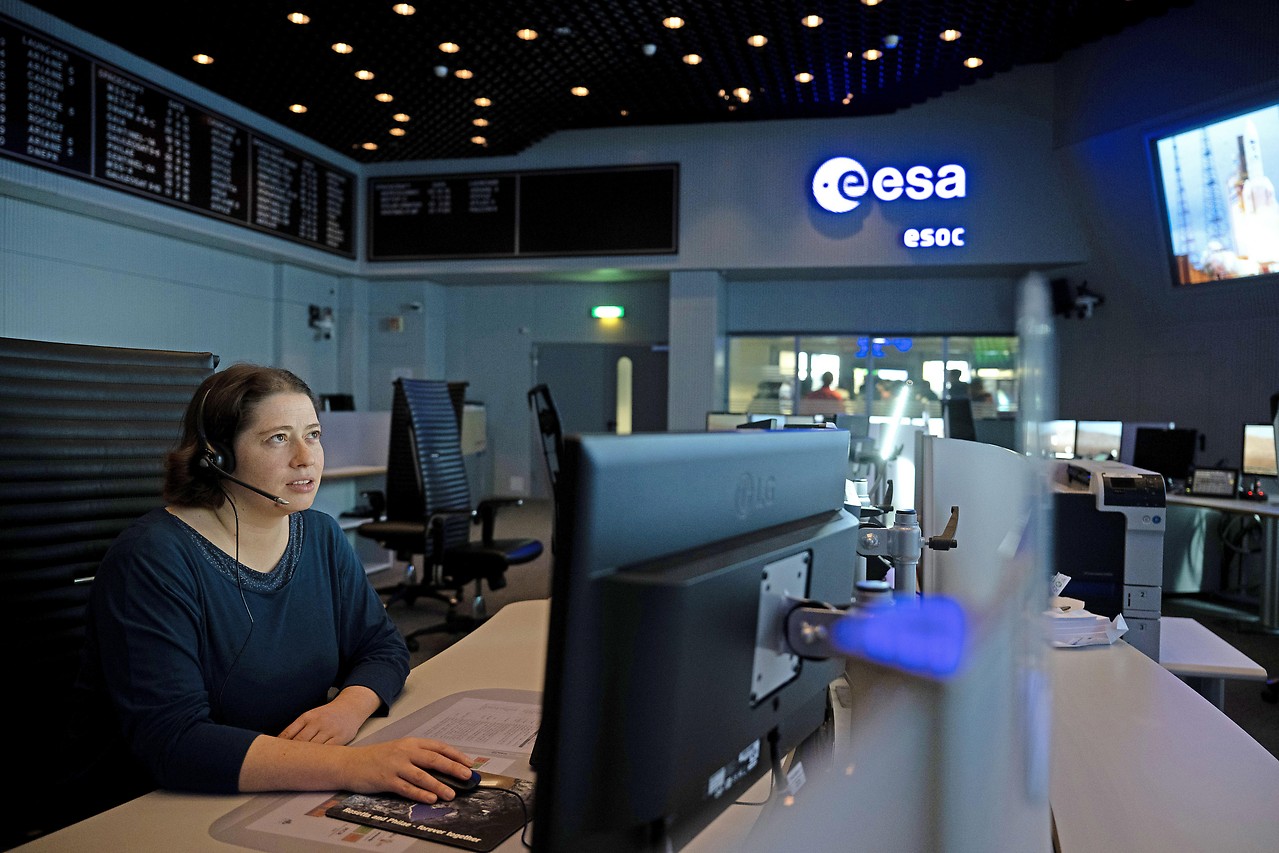For ESA’s first exploration tour of the outer solar system, the 5.2 ton (launch weight) probe will initially be on the road for eight years. She will fly once around Venus and three times around the earth to gain momentum for the long journey. Planned arrival at the largest planet in the solar system, with an equatorial diameter of around 143,000 kilometers, is in July 2031.
Then the probe will make 35 flybys of Europa, Callisto and Ganymede in more than three years. The powerful gravity of Jupiter is then used to steer the spacecraft into orbit around Ganymede. By September 2035, “JUICE” will orbit this largest moon in the solar system – as the first probe ever to enter orbit around a moon other than Earth’s moon. At the end of the mission, it should be brought to a controlled crash on Ganymede.
Gas giant is to be better understood
“JUICE” will examine the Jovian system as a prime example for gas giants in the universe. To do this, the probe takes a close look at the complex environment of the planet with its more than 90 moons. To understand how a typical gas giant formed, how it works and how its moons formed or are forming it, Jupiter’s turbulent atmosphere, strong magnetic field, dust rings and smaller moons are analyzed.
There are many questions for science to answer: Why is the planet’s Great Red Spot shrinking, and what chemical processes are taking place inside? How does its powerful magnetic field affect conditions on the icy moons? What is the volcanic activity like on Jupiter’s moon Io?
Ice Moons as “Primary Target”
But the focus of interest is on the three icy moons, particularly the giant Ganymede, which ESA calls its “primary target.” Ganymede, Callisto, and Europa are believed to harbor oceans of liquid water beneath their icy crusts. That would be one of the most important prerequisites for the fact that life could exist there or once existed.
A direct proof of life will not be possible with the 1.6 billion euro mission. Rather, she aims to find out if there might be places where there are conditions like water, biologically important elements, energy, and stability that could support life.
Europe under strong radiation
Angela Dietz from the ESA control center in Darmstadt, Germany, saw “the greatest probability” of this when presenting the mission at Europa, because this moon is closer to Jupiter and therefore has more heat and energy. With a diameter of around 3,100 kilometers, Europa is the smallest of the four large moons of Jupiter, also known as “Galilean moons”, and only slightly smaller than Earth’s moon (3,500 kilometers).
Because of the intense radiation around this near-Jupiter moon, JUICE will only fly past Europa twice, coming within 400 kilometers of its craggy icy surface, from which water vapor escapes into space via geysers. The spacecraft will search for biosignatures and water deposits, and study its surface, subsurface and geology.
“JUICE” will fly past Callisto, the second largest moon of Jupiter and the third largest moon in the solar system with a diameter of 4,800 kilometers, 21 times, approaching the heavily cratered and inactive surface to within 200 kilometers. According to the ESA, the main goal of the analyzes of this satellite is to gain insights into the environment of early Jupiter.
Ganymede: A moon with a magnetic field
Why Ganymede is so unique is the focus of research on this, the largest moon in the solar system with a diameter of around 5,300 kilometers, which even exceeds the size of Mercury. Ganymede is the only moon in the solar system that generates its own magnetic field. During twelve flybys at a distance of 400 kilometers and the subsequent orbit at an altitude of 500 kilometers, not only this magnetic field will be explored, but also the hidden ocean, the core of the celestial body and its interaction with Jupiter.
In order to accomplish all this, “JUICE” has ten instruments on board, for measuring magnetic and gravitational fields as well as charged particles and for examining the surfaces with cameras and spectrometers in a wide range of wavelengths. In addition to these optical camera and remote sensing systems, there is also a radar echo sounder, a laser altimeter and a magnetometer.
The surface of Ganymede is to be measured with the laser altimeter, among other things to obtain information about the tidal deformation caused by the enormous gravitational pull of the gas giant. Such changes in altitude could also allow statements to be made as to whether there is a global ocean on Ganymede, as model calculations predict.
Research from Austria included
Austria is one of 23 countries that participated in “JUICE”. The Institute for Space Research (IWF) of the Austrian Academy of Sciences (ÖAW) in Graz is involved in three instruments. Together with the Institute for Experimental Physics at Graz University of Technology (TU), the IWF researchers have developed a novel quantum interference magnetometer.
It is part of a magnetic sensor system that was built together with Imperial College London and TU Braunschweig. The Graz sensor sits at the end of a ten meter long boom so that it is not disturbed by the probe’s magnetic fields.
“literally look inside”
With the magnetometers, the oceans under the ice layer of the moons are to be examined in particular. As they move through Jupiter’s magnetic field, electric currents should be induced in the water, which in turn create magnetic fields. By measuring them, “we can literally look into the moons. The more precisely we know the magnetic field, the easier it is to study the deep-lying oceans,” said Werner Magnes from the IWF.
The sensor from Graz registers the smallest magnetic field fluctuations, from which the researchers want to determine the size of the oceans. In combination with the data from the other instruments with IMF participation, they also hope to more accurately determine the salinity of the water under the ice.
Extreme environment for measuring instruments
GeoSphere Austria made it possible to calibrate the magnetic field sensors in its underground Conrad Observatory on the Trafelberg in Lower Austria, which is magnetically completely undisturbed due to its remoteness. The IWF has also been involved in calibrating the antennas of the radio wave instrument and is a member of the team for the charged particle measurement instrument. The Viennese company Terma provided the power supply for the space probe on the launch pad and equipment for testing the radio connection with “JUICE”.
The extreme environment poses a particular challenge for the instruments. The probe is exposed to plus 250 degrees Celsius when it flies past Venus and minus 230 degrees Celsius when it flies past Jupiter. The thermal insulation from “JUICE” made by the Viennese space company Beyond Gravity, which consists of more than 20 layers of coated polyimide film and is intended to achieve the insulating effect of a meter-thick brick wall in the vacuum of space, ensures a stable internal temperature.
In addition, protective shields must protect the sensitive electronics from the intense radiation around Jupiter. Another challenge is the sunlight, which is 25 times weaker than that of the Earth and is captured by solar cells with an area of 85 square meters. In addition, there is a distance of millions of kilometers from Earth, which is why a powerful on-board computer should be able to solve some problems itself.




